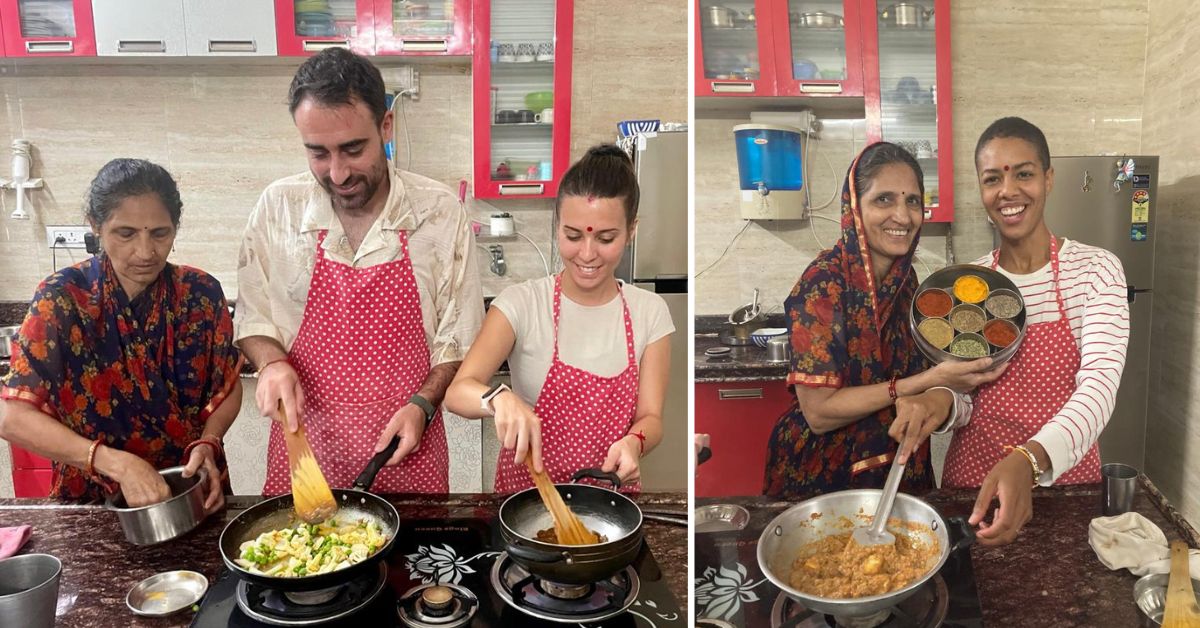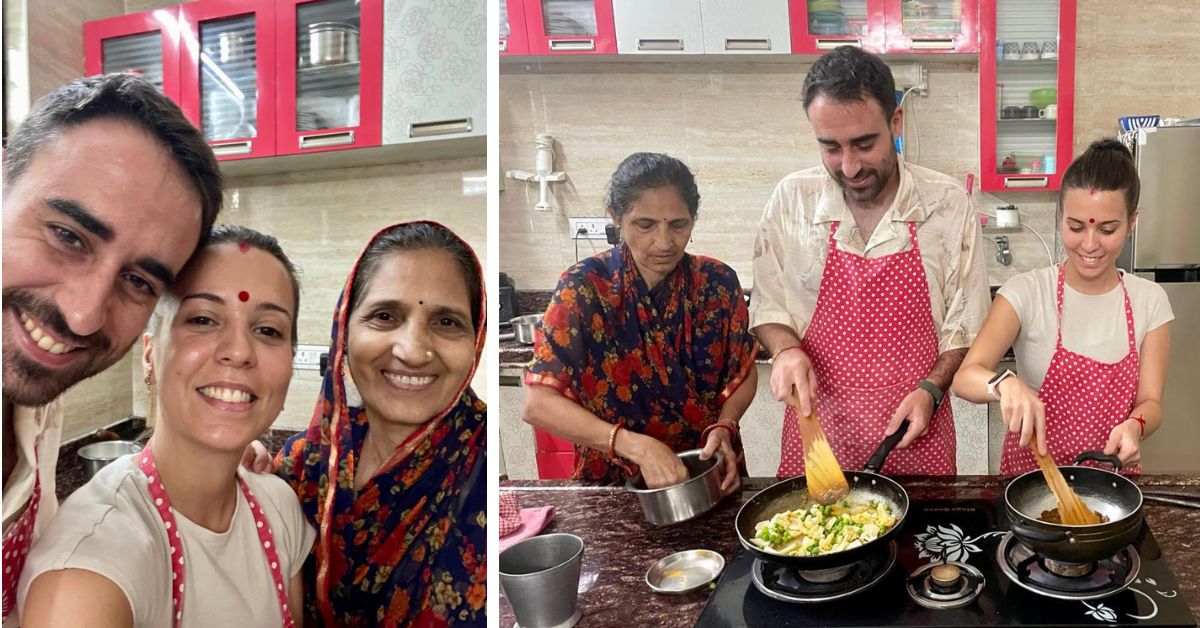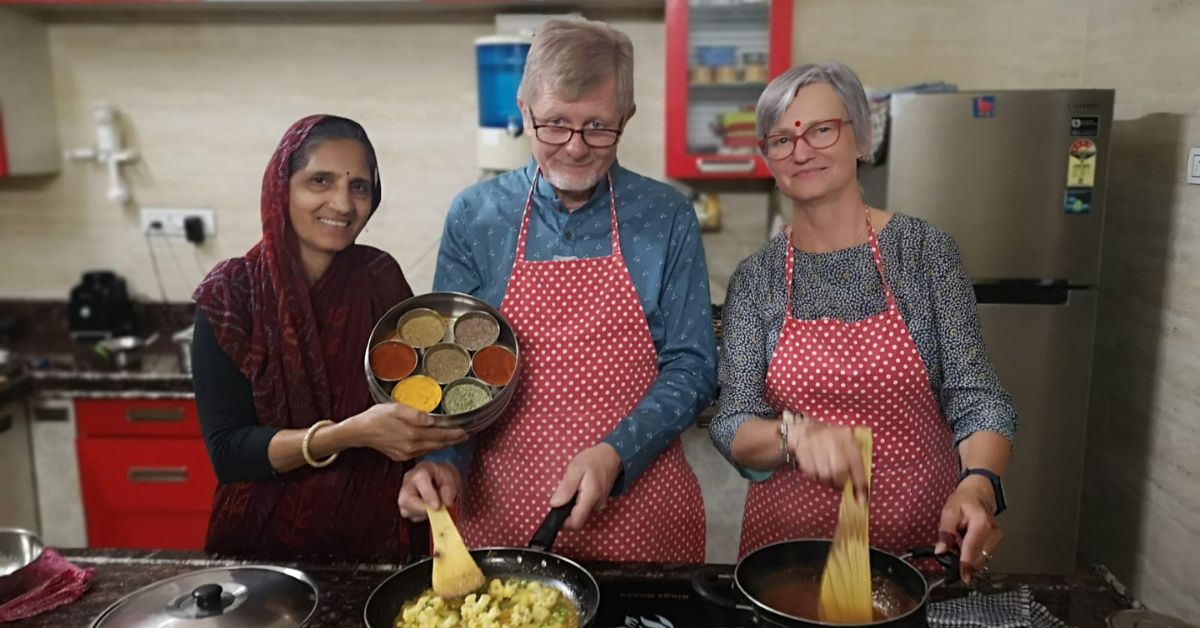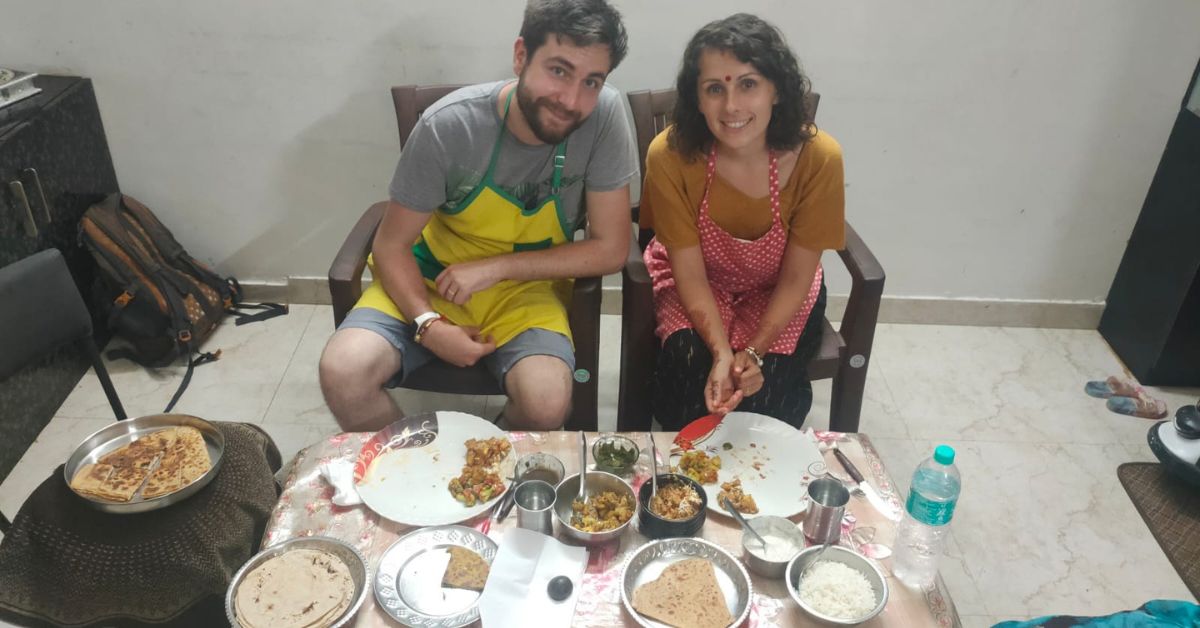60-YO Teaches The Art of Indian Cooking to Tourists From Poland, Italy & Across the World
After losing her husband, Shashikala Sanadhya took care of her family by starting Shashi Cooking Classes. So far, she has taught over 1,000 foreign tourists how to cook homely Indian food like chapati, naan, pakora, chutney and more.

Whenever Spain’s Daniel Cuenca would get a chance, the foodie would be on the lookout for Indian restaurants in his hometown Madrid. He especially enjoyed eating crispy pakoras (fritters), which he says are his favourite!
But he doesn’t need to hunt for restaurants to enjoy his favourite Indian dishes any more. On his recent tour to India, Daniel learnt to cook various kinds of dishes like pakora, dal, alu gobi, pulao, naan, and many other delicacies of the country.
“My wife and I are foodies. Every time we visit a new country, we try to learn about its cuisine. When we came to India, we found the flavours of the food to be completely different from the Indian food we had in Spain. Here the spices have a stronger flavour,” he says.

Udaipur’s 60-year-old Shashikala Sanadhya, a homemaker turned culinarian, is the one who taught Daniel and his wife the art of Indian cooking.
Shashi runs cooking classes to teach Indian cuisine to foreign tourists. She says she has trained at least 1,000 foreigners from Italy, Russia, Ireland, Switzerland, and Poland, so far.
The pursuit of a better life for children
Shashi, born and raised in a small Rajasthan village, was happily married to a hotel manager. One night, she grew worried when her husband didn’t return from work. However, he called to reassure her that he would be back the next morning.
“He asked me to prepare urad daal paratha (flat bread stuffed with black lentils). I had kept the filling and dough ready the next morning. But then I received a call and my life was shattered,” she tells The Better India.
“They told me that he was no more. My husband was murdered in a conspiracy for money,” she shares. “Losing him was so painful. I had lost all hope to live, but I had two sons to look after.”
Shashi’s sons were aged five and seven years when her husband died in 2001. “I did not have enough money to even arrange for pagdi dastoor (a Rajasthani tradition wherein responsibilities of the dead are passed to their son). We survived on namak mirch roti (flatbread with chilly and salt) for days,” she recalls.

“Neither did my peehar (father’s home) nor my in-laws support me in raising my children. So, after my husband’s death, I had to withdraw them from their English medium school and enrol them in a government-run school,” she adds.
To make ends meet, Shashi washed tourists’ clothes until 2008 when she had a visitor from Ireland.
“He told us that he admires Indian food a lot. And since he was our guest, I thought of offering him the food we had. I did not have sufficient means, so I could only serve him roti sabzi, but he said it was delicious. He was in Udaipur for four to five days and he visited us each day. I would cook various vegetables for him and he relished them all. He even wanted to learn how the food was cooked,” she says.
This incident gave her the idea to start cooking classes for tourists and ‘Shashi Cooking Classes’ was born.
Her ‘English Vinglish’ Moment
Recalling her initial experience of setting up the class, she says, “I did not have a good kitchen. We just had a small wooden table. Our first guest was an Australian couple. I was so nervous, my hands were shaking and I was also sweating. I even dropped a teacup, but they encouraged me by saying that it was okay,” she says.

“In my next class, there were French tourists. They did not know English and I did not know French. They would look at my face, I would look at theirs! If they said dekho (d’accord in French means ‘okay’ and dekho in Hindi means ‘see’), I would start staring at places and everyone would burst into laughter,” she shares amidst giggles.
Despite the language barriers, Shashi received much affection from foreign guests who also tried to teach her their languages. From knowing only Rajasthani, she can now speak basic words in English and several other foreign languages.
“I had to learn these languages because, without that, it would be difficult to explain my cooking methods to foreigners. For example, I learnt that aata is known as whole wheat flour in English and farine de blé entier in French,” she says, while carefully pronouncing the words. To memorise them, she would write all these words in Hindi in her diary.
A Recipe to Success
The admirers of Indian cuisine reach Shashi Cooking Classes through local guides, tour operators, and bloggers. Shashi first teaches them how to prepare masala chai, then moves on to chutneys of coriander and dried mango, followed by pakoras of paneer, potatoes, and mixed vegetables.

She also teaches them how to cook dal (lentil gravy), alu gobi (potato cauliflower stir fry), paneer butter masala (gravy cooked with cottage cheese), chapati, gatte ki sabji (a traditional Rajasthani curry made with chickpea flour sausages), and naan (flatbread).
Shashi cooks a unique kind of garlic cheese made from hung curd, pepper, and chopped garlic which is applied over hot naan or chapati and served with tomato curry. “Our guests love it,” she says with pride.
After a five-hour class, which is priced at INR 1,500 per person, the guests relish the cooked meals.
Daniel shares, “The learning experience is great mainly because the classes are organised at Shashi’s home. She tells you her life story also which helps us engage with her. Both, Shashi and her son, who helps her in cooking, are very didactic; not only in following recipes, but also in teaching the basics of Indian cuisine.”
“I love cooking and I’m excited to use everything I learned from Shashi’s class in Spain. I’ll definitely put those skills into practice,” he adds.

Shashi says, “My focus is not to only earn an income from these guests but also to treat them nicely because they are our guests. They should be happy when they go back to their homes. Sometimes, they even pay me extra on their own out of love.”
Other than delectable meals, these tourists also enjoy Shashi’s company, who does not miss a chance to entertain them.
“I apply henna on their palms and help our women guests wear a saree with bangles and bindi. I also apply sindoor (vermillion) to them. They are enthusiastic to participate in all these activities and show a keen interest in knowing the Indian culture. They often request me to narrate stories of gods and goddesses, explain the significance of tulsi (basil) plant, etc,” she says.
“We also celebrate their birthdays. In their own dialects, they lovingly call me ‘aunty’,” she adds with a smile. If you found our stories insightful, informative, or even just enjoyable, we invite you to consider making a voluntary payment to support the work we do at The Better India. Your contribution helps us continue producing quality content that educates, inspires, and drives positive change. Choose one of the payment options below for your contribution- By paying for the stories you value, you directly contribute to sustaining our efforts focused on making a difference in the world. Together, let’s ensure that impactful stories continue to be told and shared, enriching lives and communities alike. Thank you for your support. Here are some frequently asked questions you might find helpful to know why you are contributing?

For Shashi, teaching these foreign tourists helps her feel empowered. “I always believed in hard work. No one can defeat you if you believe in yourself. Roya daan nai milta, aur maangi bheek (You won’t always get alms by crying). I have learnt that there is no point in crying in front of others, empower yourself to go on,” she says.
Edited by Pranita Bhat
This story made me
- 97
- 121
- 89
- 167












